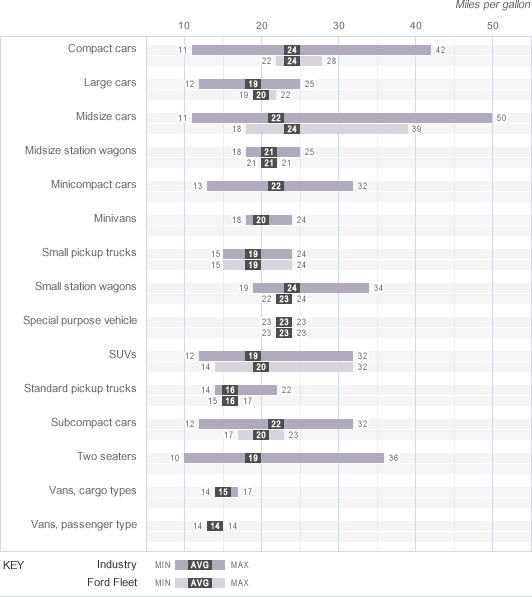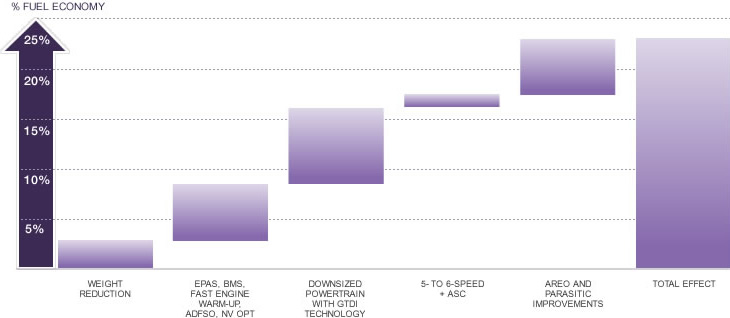-
MATERIAL ISSUES
- Materiality Analysis
-
Climate Change
- Climate Change: Related Commitments and Progress
- Greenhouse Gas Emissions Overview
- Climate Change Risks and Opportunities
- Our Strategy: Blueprint for Sustainability
- Ford's Sustainable Technologies and Alternative Fuels Plan
-
Progress and Performance
- Vehicle
- Fuel
- Driver
- Facilities
- Logistics
- Supply Chain
- Climate Change Policy and Partnerships
- Electrification: A Closer Look
- Mobility
- Human Rights
- Vehicle Safety
- Sustaining Ford
- Perspectives on Sustainability
Toolbox
Vehicle
On This Page
In the United States, for the 2009 model year, our fleet CO2 emissions decreased (i.e., improved) by approximately 5 percent relative to the 2008 model year and 12 percent compared to the 2006 model year. Preliminary data for the 2010 model year shows a 3.2 percent improvement in Corporate Average Fuel Economy (CAFE) for cars and a slight decline of 2.4 percent in CAFE for trucks as compared to 2009. The increase for cars is due to increased customer demand for the more fuel-efficient medium-sized cars, which rose by 18 percent. This includes increased demand for the newly introduced 2010 Fusion Hybrid. The decrease in truck CAFE can be attributed to increased demand for standard pickup trucks and larger SUVs, which increased by 6 percent and 5 percent respectively.
As seen in the Fuel Economy of U.S. Ford Vehicles by EPA Segment graphic (below), compared to the industry fuel economy average, Ford's 2010 model year U.S. vehicles rank better than average in four of 10 categories, worse in two and the same in four.
In Europe, we achieved a significant reduction in average vehicle CO2 emissions of 8.1 g/km from 2008 to 2009. This was largely due to changed model mix, or selling a higher proportion of smaller cars, which was likely caused by the economic downturn in 2009. We have reduced the average CO2 emissions of the vehicles we sell by 27.1 percent compared with a 1995 baseline and 6.7 percent compared to the 2006 model year.1 We have achieved this through the introduction of a variety of innovations, such as advanced common rail diesel engines available across the European model range – including the ECOnetic range of low-CO2 vehicles – and the use of lightweight materials.
These improvements – and progress in other regions – are the result of delivering on our climate change product strategy by introducing new vehicles and improving existing ones to deliver lower CO2 emissions, along with better performance and features customers want. Some examples of actions by region are below. (Also see Improving Fuel Economy.)
Fuel Economy of U.S. Ford Vehicles by EPA Segment

| Industry | Ford | |||||
|---|---|---|---|---|---|---|
| Minimum | Average | Maximum | Minimum | Average | Maximum | |
| Total | 10 | 21 | 50 | 14 | 21 | 39 |
| Compact cars | 11 | 24 | 42 | 22 | 24 | 28 |
| Large cars | 12 | 19 | 25 | 19 | 20 | 22 |
| Midsize cars | 11 | 22 | 50 | 18 | 24 | 39 |
| Midsize station wagons | 18 | 21 | 25 | 21 | 21 | 21 |
| Minicompact cars | 13 | 22 | 32 | - | - | - |
| Minivans | 18 | 20 | 24 | - | - | - |
| Small pickup trucks | 15 | 19 | 24 | 15 | 19 | 24 |
| Small station wagons | 19 | 24 | 34 | 22 | 23 | 24 |
| Special purpose vehicle | 23 | 23 | 23 | 23 | 23 | 23 |
| SUVs | 12 | 19 | 32 | 14 | 20 | 32 |
| Standard pickup trucks | 14 | 16 | 22 | 15 | 16 | 17 |
| Subcompact cars | 12 | 22 | 32 | 17 | 20 | 23 |
| Two seaters | 10 | 19 | 36 | - | - | - |
| Vans, cargo types | 14 | 15 | 17 | - | - | - |
| Vans, passenger type | 14 | 14 | 14 | - | - | - |
North America
In North America, we continued to introduce new vehicles and technologies that offer outstanding fuel economy. For example, during 2009 and early 2010, we:
- Launched two new hybrid vehicles – the Ford Fusion Hybrid and Mercury Milan Hybrid – and announced the launch in 2010 of the Lincoln MKZ Hybrid, which will be the most fuel-efficient luxury sedan available in North America.
- Introduced the Transit Connect to North America, creating a new class of nimble commercial vans with outstanding fuel economy. The Transit Connect will be the basis for Ford's first 21st century battery electric vehicle.
- Prepared for the launch of our global compact car, the Ford Fiesta. When it launches in the United States in 2010, it is expected to have best-in-class fuel economy in its segment.
- Announced plans for the 2011 Mustang, which will be the first car ever to achieve 300-plus horsepower and 30-plus miles per gallon. The 2011 Ford Mustang equipped with a six-speed transmission and V6 engine is certified by the EPA at 31 mpg on the highway and 19 mpg in the city.
- Announced plans for the all-new Ford Explorer, which will have 25 percent better fuel economy than the previous model.
Europe
Ford already offers one of the broadest low-CO2 vehicle portfolios in Europe. With the launch of the new generation of the Focus ECOnetic,2 we extended the availability of best-in-class or among-best-in-class, extremely low-CO2 vehicles, which now include the following:
- The all-new Fiesta 1.6-liter 90 PS TDCi, available since January 2009, is the most fuel-efficient five-seat family car in the UK at 63.6 mpg, and it emits only 98 g/km of CO2.
- The second generation of the Ford Focus ECOnetic, 1.6-liter 109 PS TDCi with conventional technology has class-leading 104 g/km CO2 emissions (which corresponds to a fuel consumption of 4.0 l / 100 km).
- The second-generation Focus ECOnetic equipped with optional start/stop technology achieves 99 g/km CO2, corresponding with a fuel consumption of 3.8 l / 100 km.
- A 139 g/km CO2 Mondeo 1.8- and 2.0-liter TDCi (115–125 PS), since autumn 2008.
After the successful introduction of the new EcoBoost™ gasoline engine family in the United States, Ford will launch 2.0- and 1.6-liter EcoBoost engines in Europe in 2010. These turbocharged, direct-injection gasoline engines will deliver up to 20 percent better fuel economy and fewer CO2 emissions compared to conventional gasoline engines.
In addition, our global electric vehicles plan is extending to Europe with five full electric or hybrid vehicles. Specifically, Ford will launch two zero-emission full battery electric vehicles, including the Transit Connect Electric light commercial vehicle in 2011 followed by the Ford Focus Electric in 2012. Three other vehicles – two next-generation gasoline hybrid vehicles and a plug-in hybrid – will be introduced in 2013.
Ford of Europe's innovative Product Sustainability Index (PSI) shows how the vision of sustainability can be made operational. By combining comprehensive sustainability criteria into the earliest stages of the product development process, Ford's PSI provides a ground-breaking design-for-sustainability tool. Designers can use it to assess the life-cycle CO2 emissions of a vehicle, and consumers can use it to understand a vehicle's footprint.
Asia Pacific
In our Asia Pacific and Africa region we are focusing our near-term fuel efficiency efforts on implementing EcoBoost engines and our PowerShift transmission technology, which we plan to introduce across our vehicle lineup in this region in the next few years. In China we will introduce the Ford Mondeo with an EcoBoost engine and PowerShift transmission in 2010. We expect it to be best in its segment for fuel economy when it launches. We also will be launching the Ford Fiesta with a 1.6-liter Ti-VCT powertrain and six-speed PowerShift transmission throughout our Asian markets. This vehicle will be the first in the "B-car" segment to offer consumers this level of sophistication in powertrain technology, and it will be among the leaders in its segment in fuel economy. In India, we recently introduced the Ford Figo, which has very fuel-efficient 1.4-liter TDCi diesel and 1.2-liter gas engine options. This introduction is highly significant to our success in India, as fuel economy is the most important criteria in purchase consideration in that country.
South America
In South America, we are improving fuel economy by introducing some of the efficient engine and transmission technologies currently used in North America, and by using technologies specifically relevant to the widespread use of biofuels in Brazil. For example, we have implemented improved engine compression ratios – or the ratio in which the air and fuel mixture is compressed in the engine combustion chamber – on flexible-fuel vehicles in Brazil. This optimizes fuel efficiency in vehicles using biofuels, which have a higher octane rating than petroleum-based gasoline. We have also improved the gearing ratios and aerodynamics of our South American models, further increasing fuel economy, and we will introduce a more fuel-efficient engine in the Focus in 2010.
The figures below show how we are leveraging complementary technologies to cut CO2 emissions significantly.
Typical Near-Term Fuel Economy Improvements
Midsize Utility

Small Car

For an explanation of the terms used in these figures, see the glossary.
Please note that improvements in fuel economy resulting from the use of the technologies identified in the above charts are often not additive or linear. The charts depict approximate percentage improvements estimated for particular technologies in a generic vehicle; actual improvements will vary depending on the characteristics of each specific vehicle.